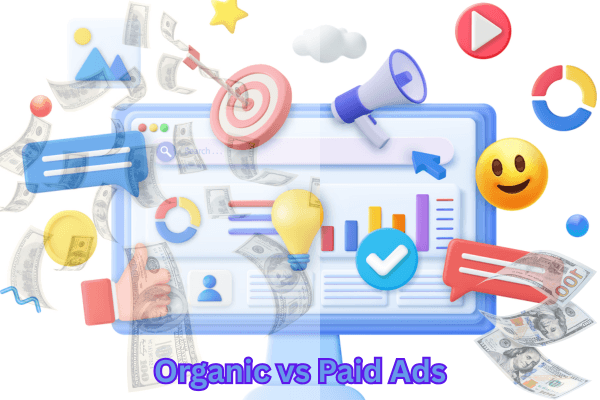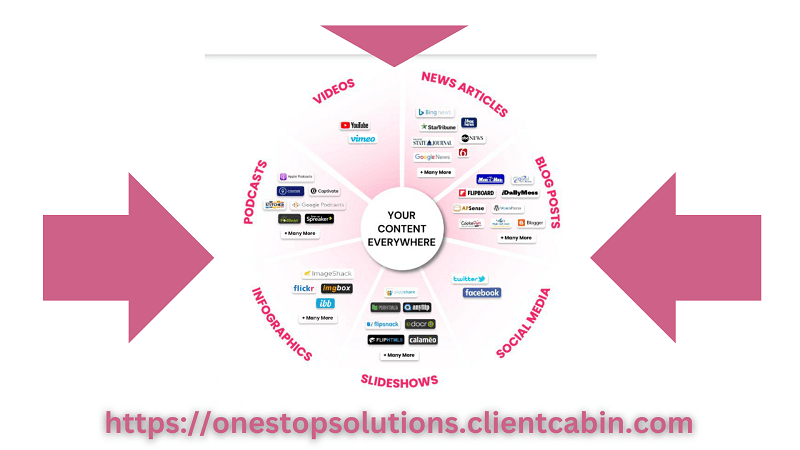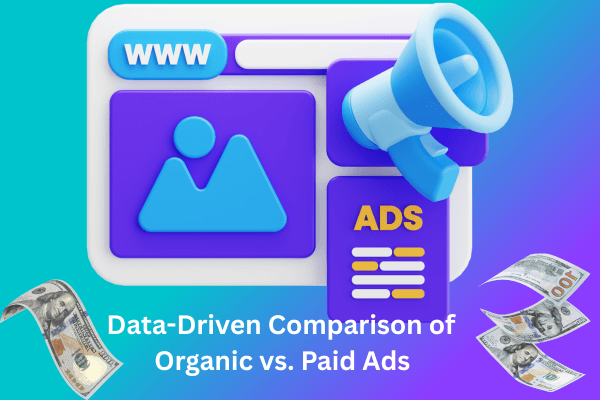A Data-Driven Comparison of Organic vs Paid Ads
A Data-Driven comparison of organic vs paid Ads reveals that whilst paid ads provide immediate data, organic strategies shine when it comes to long-term trends.
When we talk about advertising, understanding the difference between organic and paid ads is crucial. Both have unique advantages and limitations, and knowing how to use each can significantly impact your marketing success.
Organic ads are essentially unpaid strategies that focus on building your presence naturally over time. This can include things like SEO, content marketing, and social media engagement. The main advantage here is trust. When people find you organically, they’re more likely to trust your brand. However, it takes time and consistent effort to see results.
On the other hand, paid ads are exactly what they sound like—advertisements that you pay for. These can include Google Ads, Facebook Ads, and other pay-per-click (PPC) campaigns. Paid ads are great for immediate results and allow for precise targeting. You can reach specific demographics quickly, but the cost can add up fast, and once you stop paying, the ads disappear.
“Organic search provides valuable and deep insights through tools such as Google Analytics. However, it lacks the real-time granularity that paid social platforms offer.”
In essence, both organic vs paid ads have their place in a well-rounded marketing strategy. It’s about understanding when and how to use each to your advantage.
Immediate Metrics from Paid Ads
One of the greatest benefits of paid ads is the ability to track and measure your success immediately. Platforms like Google Ads and Facebook Ads provide detailed analytics that show how your campaigns are performing in real-time. This data is invaluable for making quick adjustments to improve your return on investment (ROI).
Long-term Trends through Organic Data
While paid ads provide immediate data, organic strategies shine when it comes to long-term trends. Using tools like Google Analytics, you can gather insights into how your audience interacts with your content over time. This helps you understand trends, audience behaviors, and the effectiveness of your content strategy.
For instance, if you notice a particular blog post consistently attracts traffic, you can create more content around that topic. This is the power of organic data—it helps you make informed decisions that can lead to sustainable growth.
Real-time Strategy Adjustments with Paid Ads
Because paid ads offer immediate feedback, they allow for real-time strategy adjustments. If a particular ad isn’t performing well, you can tweak it on the fly. Change the headline, adjust the targeting, or even pause the ad altogether. This flexibility can save you money and ensure your campaigns are as effective as possible.
Understanding Audience Behavior Across Platforms
Both organic vs paid ads provide insights into audience behavior, but they do so in different ways. Organic strategies show you what content resonates with your audience over time, while paid ads reveal immediate preferences and behaviors.
By combining these insights, you can get a comprehensive understanding of your audience. This holistic view enables you to create more effective marketing strategies that cater to your audience’s needs and preferences.

Dissecting Organic vs Paid Ads
Before diving deeper into the specifics, let’s define what we mean by organic vs paid ads. Understanding these definitions is key to leveraging them effectively in your marketing strategy.
- Organic Ads: These are unpaid strategies that naturally build your brand’s presence over time. Examples include search engine optimization (SEO), content marketing, and social media engagement.
- Paid Ads: These involve paying for advertisements on various platforms. Examples include Google Ads, Facebook Ads, and other pay-per-click (PPC) campaigns.
Both types of ads play a critical role in digital marketing, and knowing when to use each can make all the difference in your campaign’s success.
Definition and Scope of Organic Ads
Organic ads focus on building your brand’s presence naturally. This means creating high-quality content that resonates with your audience, optimizing your website for search engines, and engaging with your audience on social media. It’s about building trust and authority over time.
Definition and Scope of Paid Ads
Paid ads, on the other hand, are about getting immediate visibility. You pay for advertisements that appear on search engines, social media platforms, or other websites. These ads can be highly targeted, allowing you to reach specific demographics quickly. However, they require a budget, and the visibility stops when you stop paying.
Benefits and Drawbacks of Organic Ads
Now that we have a clear understanding of what organic ads are, let’s delve into their benefits and drawbacks. Understanding these aspects will help you decide when to focus on organic strategies in your marketing efforts.
Sustained Visibility and Cost-effectiveness
One of the biggest advantages of organic ads is their cost-effectiveness. Unlike paid ads, which require a continuous budget, organic strategies rely on time and effort. This makes them an attractive option for businesses with limited marketing budgets.
Moreover, organic ads offer sustained visibility. Once you’ve built a strong presence, your content can continue to attract traffic over time without additional costs. This long-term visibility is a significant advantage over paid ads, which disappear once you stop paying.
Challenges in Tracking and Adjustments
Tracking the performance of organic ads can be challenging. Unlike paid ads, which offer immediate metrics, organic strategies often require a longer timeframe to yield significant data. This delay can make it difficult to assess the immediate impact of your efforts and adjust your strategy accordingly.
Moreover, the lack of direct control over search engine algorithms can make tracking even more complex. SEO, for instance, is subject to frequent changes in search algorithms, which can impact your rankings and visibility. Staying updated with these changes is crucial for maintaining your organic presence.
Despite these challenges, the insights gained from organic data are invaluable for long-term strategic planning. By consistently monitoring your organic performance, you can identify trends and patterns that inform future marketing decisions.
Benefits and Drawbacks of Paid Ads
Paid ads come with their own set of benefits and drawbacks. Understanding these can help you decide when to invest in paid campaigns and how to optimize them for maximum impact.
“Paid social media is adept at reaching new audiences, making it suitable for product launches or market expansions.”
Paid ads are ideal for businesses looking to expand their reach quickly. They offer precise targeting options, allowing you to reach specific demographics with tailored messages. This precision can lead to higher conversion rates, as you’re reaching people who are more likely to be interested in your products or services.
However, the cost of paid ads can be a significant drawback. Campaigns can become expensive, especially if not managed properly. It’s essential to monitor your spending and ensure that your ads are delivering a positive return on investment (ROI).
Immediate Results and Precise Targeting
The primary advantage of paid ads is the ability to achieve immediate results. Unlike organic strategies, which take time to build momentum, paid ads can generate traffic and conversions quickly. This is particularly beneficial for time-sensitive campaigns or product launches.
Cost Implications and ROI Considerations
While paid ads can deliver quick results, they come with cost implications. It’s crucial to carefully plan your budget and set clear goals for your campaigns. By doing so, you can ensure that your ads are cost-effective and provide a positive ROI.
Consider using A/B testing to optimize your ads and maximize their effectiveness. This involves creating multiple versions of an ad and testing them to see which performs best. By continually refining your ads, you can improve their performance and reduce costs.
Data-Driven Insights for Strategic Decisions on Organic vs Paid Ads
Data is at the heart of effective advertising. Whether you’re using organic or paid strategies, leveraging data can help you make informed decisions that drive results.
Metrics for Measuring Success
To measure the success of your ads, focus on key metrics such as click-through rates (CTR), conversion rates, and cost per acquisition (CPA). These metrics provide valuable insights into the performance of your campaigns and help you identify areas for improvement.
Leveraging Analytics for Campaign Adjustment
Analytics tools are essential for tracking the performance of your ads and making necessary adjustments. Platforms like Google Analytics and Facebook Ads Manager offer detailed insights into how your ads are performing. Use these insights to refine your targeting, messaging, and budget allocation.
Case Studies Highlighting Effective Strategies
Learning from successful case studies can provide valuable insights into effective ad strategies. For example, consider a company that used a combination of organic and paid ads to launch a new product. By leveraging organic content to build anticipation and paid ads to reach a wider audience, they achieved a successful launch with high engagement and sales.
Optimizing Combined Use of Both Organic vs Paid Ads Approaches
Combining organic and paid ads can maximize your marketing efforts. By leveraging the strengths of both organic vs paid ads strategies, you can achieve greater visibility and reach your target audience more effectively.
Crafting a Balanced Strategy
To craft a balanced strategy, start by identifying your business goals and target audience. Determine which aspects of your marketing efforts would benefit from organic strategies and which would benefit from paid ads. By aligning your strategy with your goals, you can ensure that your resources are used effectively and your campaigns deliver results.
Remember, the key to successful advertising is flexibility. Be prepared to adjust your strategy based on data and insights, and always be on the lookout for new opportunities to engage your audience.
Aligning Ads with Business Goals
Aligning your ad strategy with your business goals is essential for maximizing the impact of your marketing efforts. Start by clearly defining what you want to achieve. Is it increased brand awareness, lead generation, or sales? Once you have a clear goal, tailor your ad strategy to meet these objectives.
For instance, if your goal is to increase brand awareness, focus on organic strategies that build trust and authority over time. Use content marketing and SEO to create valuable content that resonates with your audience. For immediate results, complement these efforts with paid ads that target specific demographics likely to be interested in your brand.
Thoughts on Organic vs Paid Ads Strategy Effectiveness
- Organic ads are cost-effective and build long-term trust but require patience.
- Paid ads offer immediate results and precise targeting but can be costly.
- Combining both strategies can maximize reach and ROI.
- Use data analytics to track performance and adjust strategies as needed.
- Align your ad strategy with business goals for optimal resource utilization.
In the digital age, the competition for consumer attention is fierce. To stand out, businesses must employ a strategic mix of organic and paid ads. By understanding the strengths and weaknesses of each, you can craft a strategy that leverages both to achieve your business goals.
Remember, data is your ally. Use analytics to guide your decisions and continually refine your approach based on performance insights. This data-driven mindset will empower you to make informed decisions that drive success, when it comes to organic vs paid ads.
Ultimately, the key to effective advertising is adaptability. Stay flexible, be willing to experiment, and don’t be afraid to pivot your strategy based on the data you collect. This adaptability will be your greatest asset in the ever-evolving digital landscape.
Key Takeaways for Marketers
Marketers should focus on a balanced approach that combines the strengths of both organic and paid ads. By doing so, they can achieve sustainable growth and immediate visibility. Always align your strategy with your business goals and use data to make informed decisions.
Future Trends in Digital Advertising
As technology evolves, so too will digital advertising. Expect to see advancements in AI and machine learning, which will offer even more precise targeting and personalization. Marketers should stay informed about these trends to remain competitive and capitalize on new opportunities.
Frequently Asked Questions on Organic vs Paid Ads
Digital advertising can be complex, and it’s natural to have questions. Here are some common inquiries and their answers to help guide your strategy. For more insights, explore the differences between paid social media and organic search.
What are the main differences between organic vs paid ads?
Organic ads rely on unpaid strategies like SEO and content marketing to build trust over time, while paid ads involve paying for immediate visibility through platforms like Google Ads and Facebook Ads. Organic ads are cost-effective but slower, whereas paid ads are faster but require a budget.
How can I determine which ad strategy is best for my business?
Consider your business goals and budget. If you need quick results, paid ads may be the way to go. If you’re looking to build long-term trust and have a limited budget, focus on organic strategies. Often, a combination of both is the most effective approach.
What tools can help track the success of ad campaigns?
Tools like Google Analytics, Facebook Ads Manager, and SEMrush provide valuable insights into the performance of your ad campaigns. These platforms offer detailed analytics that can help you measure success and make data-driven adjustments.
How do paid ads affect the performance of organic search?
Paid ads do not directly impact organic search rankings. However, they can increase brand visibility and drive traffic, which can indirectly improve your organic performance by increasing engagement and brand recognition.
What is the most cost-effective way to advertise online?
The most cost-effective approach is to use a combination of organic and paid strategies. Start with organic methods to build a solid foundation, then use paid ads strategically to boost visibility when needed. When it comes too organic vs paid ads, always track your ROI to ensure your spending is delivering results.
Essential Insights on Data-Driven Comparison of Organic vs Paid Ads
- Organic ads build trust over time and cost less, but they require patience and consistent effort.
- Paid ads deliver immediate results and precise targeting, ideal for quick campaigns but can be expensive.
- Combining organic and paid strategies can maximize visibility and ROI by leveraging the strengths of both.
- Use analytics to track success and adjust strategies; organic provides long-term insights, while paid offers real-time data.
- Align ad strategies with business goals to ensure resources are effectively utilized and outcomes are measurable.
The comparison between organic vs paid ads clearly demonstrates that while the latter may yield immediate results, organic traffic emerges as the more cost-effective and beneficial long-term investment. The data-driven analysis presented in this article showcases the sustainability and value of organic traffic in driving continuous growth, enhancing brand credibility, and fostering lasting relationships with customers. By prioritizing organic traffic, businesses can establish a strong online presence that not only withstands fluctuations in the digital landscape but also garners greater returns over time.
While paid ads may provide a quick boost in visibility, the enduring benefits of organic traffic in terms of higher conversion rates, lower customer acquisition costs, and increased brand loyalty cannot be overlooked. Therefore, it is imperative for organizations to shift their focus towards building organic traffic strategies that will not only drive sustainable growth but also ensure a successful and enduring online presence for years to come.

